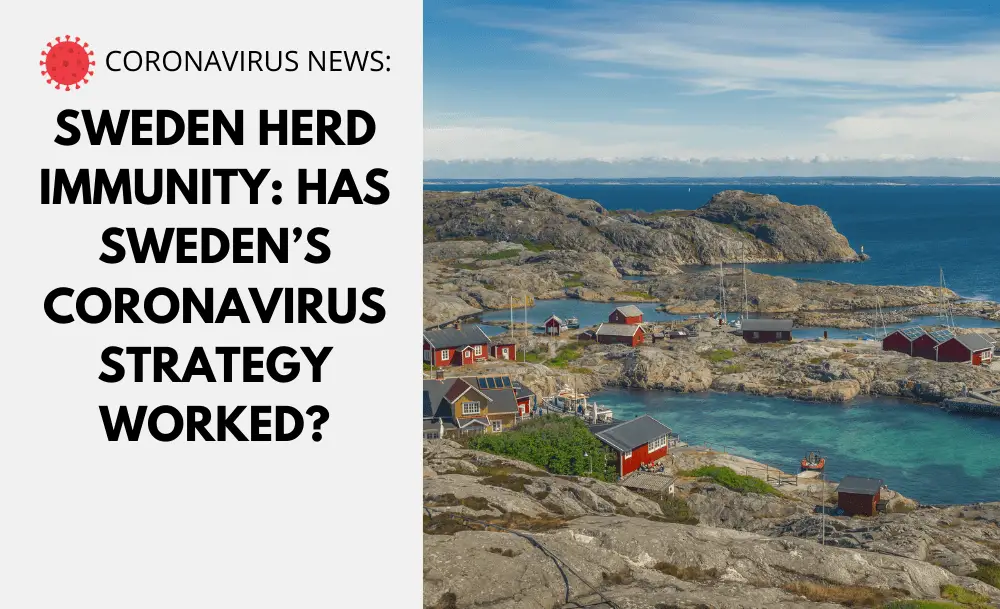Sweden Herd Immunity: Has Sweden’s coronavirus strategy worked?

Sweden has stood out as it has taken a different approach to the Coronavirus pandemic. It, like the UK, used a herd immunity approach to the virus. But unlike the UK, which dropped its herd immunity approach months later, Sweden continued its approach.
This approach to the COVID-19 pandemic was the direct opposite to its Nordic neighbours and the rest of Europe in trying to contain the spread of the novel coronavirus.
The Swedish strategy permitted people to keep living their daily lives as normal. Stores and restaurants remained open, as did schools.
Sweden's 7-day moving average of new cases was about 200, down from a peak of around 1,140 in mid-June. Its daily death totals have been in the single digits for two weeks, well below its mid-April peak of 115 deaths in a single day.
The COVID-19 death toll of Sweden currently stands at 5,700 with a mortality rate considered a quarter higher than that of the United States, when adjusted for population size.
The Swedish figure is closer to Italy's 581 deaths per million. Italy has had one of the highest COVID stats in Europe.
On a per-capita basis, Sweden’s numbers are shocking compared to its Scandinavian neighbours. Sweden has had 567 deaths per million people compared with Norway's 47 deaths per million, Finland's 59 deaths per million, and Denmark's 106 deaths per million.
But recent data is showing that the number of deaths has dropped considerably in recent weeks.
“We've actually seen a clearly declining trend in the number of patients in intensive care and also in the number of deaths since the middle of April,” said Anna Mia Ekström, clinical professor of global infectious disease epidemiology at Stockholm’s Karolinksa Institute.
She went on to state that with the summer holidays, fewer people are at work or in public transport, and they’re spending more time outdoors, so the virus is finding fewer opportunities to spread.
In July, the number of coronavirus patients in a hospital in the capital had fallen below 100 for the first time since early March, according to The Local.
“Now we see one or two deaths a day and very few persons admitted to ICU (intensive care units),” said Jan Albert, a professor of infectious disease control at the Karolinska Institute.
“We are much better off now than we were in April,” he told Euronews.
How did Sweden flatten its curve without a lockdown?
Without implementing a lockdown, Sweden has managed to flatten its curve.
So how has Sweden managed to get its outbreak under control?
Some are arguing that it is because of a behavioural change.

Behavioural Change
At the start of the outbreak in Sweden, only high schools and universities closed. Daycare and elementary schools have been open. Businesses have also remained open and have reaped the benefits, and restaurants operated in a trust culture.
The trust culture has meant that Swedes have been asked to keep their distance in public, refrain from non-essential travel, and work from home when possible. Gatherings of more than 50 people are banned. People aged 70 and over are also advised to stay away from others as much as possible.
Masks were never required and aren't commonly worn and the social distancing guidelines since the start of the pandemic, including working from home where possible and avoiding public transport have all been voluntary.
This message and approach hasn't changed through the pandemic’s rise and decline. So there's no definitive explanation for the flattening, though, and experts have several theories.
Anders Tegnell, of the Swedish Public Health Agency and architect of Sweden's coronavirus strategy, says his modelling indicates that, on average, Swedes have around 30% of the social interactions they did prior to the pandemic.
And a survey released this week by Sweden's Civil Contingencies Agency suggests 87% of the population are continuing to follow social distancing recommendations to the same extent as they were one or two weeks earlier, up from 82% a month ago.
“Swedes in general have changed their behaviour to a great extent during the pandemic and the practice of social distancing as well as physical distancing in public places and at work has been widespread,” said Maria Furberg, MD, PhD, an infectious diseases expert at Umea University Hospital in northeastern Sweden.
“During the months of March to early June, all shops were practically empty, people stopped dining with friends, and families stopped seeing even their closest relatives,”
“A lock-down could not have been more effective. Handwashing, excessive use of hand sanitizers, and staying home at the first sign of a cold became the new normal very quickly.”
Despite businesses keeping open and the economy continuing, than in other countries, forecasts predict the Swedish economy will still shrink by about 5% this year. But
What was Sweden's strategy?
Sweden’s strategy to tackle the coronavirus pandemic has been criticised both domestically and internationally.
The latest Swedish numbers has led Anders Tegnell, PhD, chief epidemiologist for the Swedish Public Health Agency, to say that the “Swedish strategy is working,”.
The Public Health Agency has not publicly stated that herd immunity was its goal, though this is what is widely reported in the media as the intention. Tegnell told reporters last week he thought the recent trends indicated that immunity was now widespread in the country.
The popularity ratings of Sweden's prime minister, Stefan Lofven, has taken a battering and he has announced an inquiry into the government's handling of the coronavirus outbreak.
So how close is Sweden to possibly reaching herd immunity?

Scientists are trying to figure out whether herd immunity from the new coronavirus can even be reached, for how long or even if its possible or ethical.
Ekström noted that the reproduction number of the epidemic – or R number, has now fallen in Sweden to around 0.6. The R-number measures the average number of people that one infected person will pass the virus on to. This means that the transmission of the virus is declining in Sweden.
The number of people with coronavirus antibodies, meanwhile, is increasing.
Data published by Sweden’s public health agency in June showed that about 10 per cent of people in Stockholm – the nation's worst affected area – had developed antibodies to COVID-19, more than anywhere else in the country.
A study from the Karolinska Institute also suggests that people testing negative for coronavirus antibodies may also have some immunity, through specific T-cells that identify and destroy infected cells.
Whether Sweden is on track to greater immunity to the new coronavirus than other countries remains one big question mark at this stage, says the Karolinska Institute's Albert.
“There are so many unknown factors about how many actually develop antibodies and other types of immune responses after going through the disease, and how many will be required to have had the disease in order to see herd immunity,” he explained.
“We know that we've had more cases in Sweden than for instance in Norway and Denmark and Finland, our neighbouring countries, many more. But whether that means that we are on our way to herd immunity is a big unknown.”
Did Sweden's coronavirus strategy succeed or fail? It remains to be conclusively determined. But time will tell. Comment below with your thoughts.
If you need any help or support, reach out to your visa coordinator at IaM











